It's been said that Belgium cooks food at French quality in Germanic quantity. This happy duality befits the split nature of this small country: the Flemish of the north speak a dialect of Dutch, the Walloons of the south speak French, and they all eat well. (For the purposes of this post I'll give the menu item names in French, if for no other reason than that I'm a lot more familiar with it than Flemish.)
When I was thinking ahead to Belgium, I figured we'd enjoy good beer with mussels, fries, and waffles. Turns out my assumptions were entirely correct, plus a few additions seasonal to the time of year. Our guest of honor on this delicious journey was Chris, who led us through a beer tasting paired with the meal. We also had on hand Chris' friend and my coworker Caro; another colleague Ginny in town from DC; Lauren and Lauryn who each brought a waffle-maker; and Laura's classmate Cassie. And in absentia, Laura's sister Jen, whose experience from a year and a half in Brussels helped us on the right path.
Bière | Beer
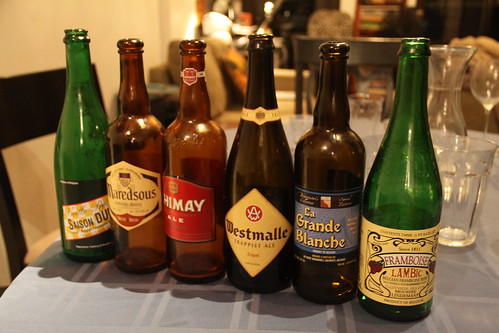
There's nothing like a Belgian beer: rich, balanced, flavorful, and each one distinctive. As you see, we tried six different ones (albeit one of them, the Maredsous, in the form of stew!), and with Chris's coaching learned a bit about them. The Dupont is in the saison style, with "only" 6.5% alcohol, was developed because workers were getting too drunk on the beer they normally drank (ya know, because water was unsanitary back then). Chimay and Westmalle are brewed by Trappist monks, two of only seven Trappist ales produced — the Chimay is a nice rich color and balanced, and while the Westmalle looks unassuming, it packs a punch of both flavor and alcohol. La Grande Blanche is a wheat beer, and the Lambic is a beer brewed without hops, so its lack of bitterness helps it take very well to the raspberries.
Moules | Mussels | Recipe (scroll down)
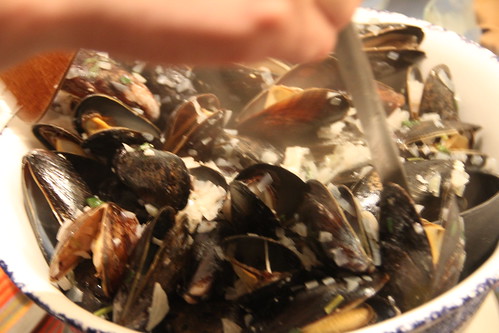
While normally I love to get creative, and for sure there are various creative recipes with blue cheese or curry or whatnot that you could find, when it comes to mussels there's just no way to improve on the classic moules marinière: simply steamed with sautéed shallots, parsley, and wine. Unlike oysters, there's no need to shuck; if they're fresh, they simply open. And thankfully that means we don't have to eat them, shell and all, like a starfish does.
Frites | Fries | Recipe

The classic Belgian pairing with mussels is fries, in fact they simply mush the names together and call it moules frites. Belgium proudly, and rightly as far as I can tell, claims to be the orignal home of the poorly named French fry. I did my best to do it right, by rendering some beef fat (albeit a small amount — there was only so far I could prod the butcher at Fairway!), blending it with vegetable oil, and then frying in small batches in two stages: once at a lower temperature to cook the potato, and then at a higher temperature (video!) to get the crisp. Whether paired with Ginny's aïoli or dipped in the mussel juice, yum.
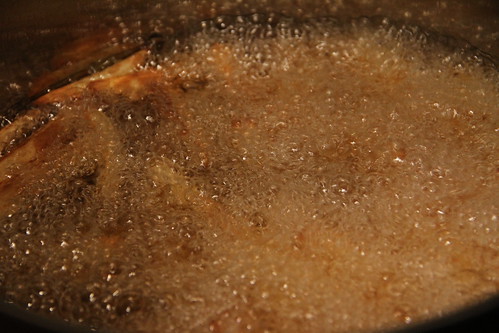
Fromage | Cheese
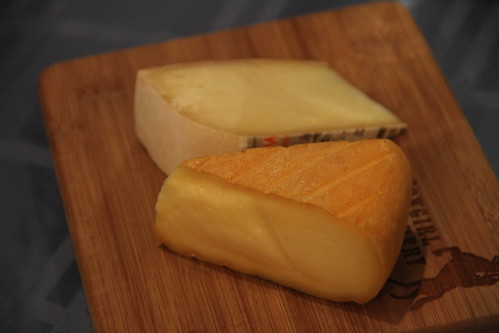
The cheese in front is from Chimay. In fact, the mash left over from brewing the beer is fed to the cows who make this cheese, which is nice and rich and gooey. Can't remember the name of the one in the back but it was good: semi-firm and with a medium ripeness.
Pain | Bread
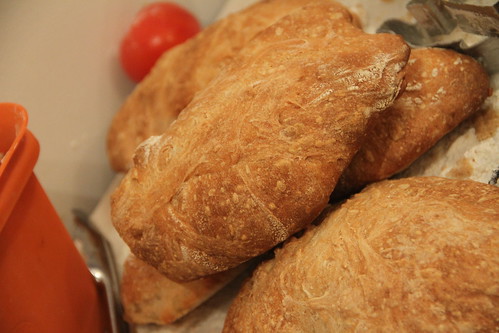
I tried to make baguettes using the poolish pre-ferment recipe in the appropriately-named cookbook Bread, but I made one crucial mistake: I added flour and then the poolish to the mixing bowl, instead of the other order. When I came back an hour later to fold the rising dough, I found that the flour on the bottom hadn't gotten mixed in, so the wet part was way too wet. Long story short, it never got nearly solid enough to make into baguettes, so I flipped to the ciabatta recipe, since ciabatta is a much wetter dough. This bread wouldn't win any design competitions, but heck, it was crusty, with good spring, and did a bang-up job sopping up sauces.
Carbonnade à la flamande | Beef and beer stew | Recipe
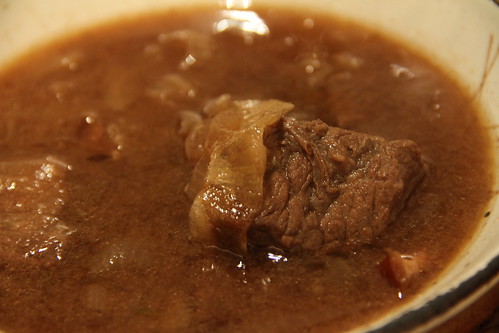
Onto the main course! This was perhaps one of the easiest big dishes I've made for United Noshes, nothing much more than beef, onion sauteed in bacon grease, beef stock...and Belgian ale! Simple, and a crowd-pleaser. Do try this one if you're so inclined, it's a lot of flavor for not much effort. I wouldn't recommend putting in as much liquid as the recipe calls for, since it ended up more like soup than stew, but it's up to you.
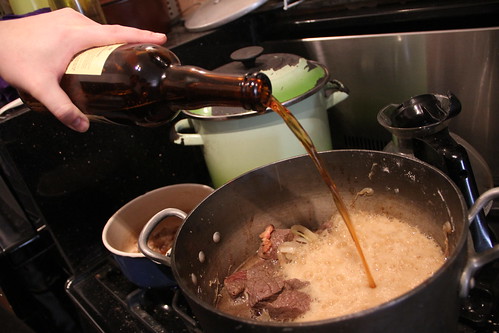
Endives braisées | Braised endives | Recipe
Endives were discovered, crazily enough, fewer than 200 years ago. Apparently it's a weird offshoot of light-deprived, over-wintered chicory, or something. Anyway, braised with little more than butter, lemon juice and sugar, a really rich, slightly bitter and complex flavor emerged that nicely counterbalanced the rich meat.
Speculoos | Holiday spice cookies | Recipe (first one in comments, in French; translation below)

December 6 is the feast of St. Nicholas, which is a big holiday for Belgian families. The traditional sweet is the oddly-named speculoos, which derives from Latin; depending on whom you ask, it comes from either the word for "spices" or for "mirror." The spices part is obvious: along with copious amounts of butter, raw sugar, and some ground-up nuts, these guys have cinnamon, nutmeg, and sometimes pepper and clove and other spices. The mirror part would refer to the imprints of animals and human figures; alas, without a speculoos mold of my own, I resorted to cookie cutters. Really yummy. See my transcription of the recipe below.
Gaufres de Liège | Caramelized-sugar waffles | Recipe

The more I do this United Noshes thing, the more I realize that dessert dishes often take the longest. First I had to brave the 2-star-reviewed specialty cake shop for non-dissolving pearl sugar. Then I had to give the batter a 75-minute rise, some mixing, a 4-hour rise, a 30-minute refrigeration, and folding up before refrigerating. Then finally, the Laure/yns mushed in the pearl sugar, and after one last 90-minute rest, it was off to the waffle-makers. And you know what? Totally worth it. The sugars, with a lot of help from the (you guessed it) absurd amounts of butter, got all perfectly caramelized on the edges. (Speaking of: today at Fairway, in preparation for some seasonal cookie-making, I bought like five pounds of locally-made butter, for no more than the commercial kinds. A new trend?)
We enjoyed some Belgian music, mostly old-timey French-language tunes, and scratched off the map for both Belarus and Belgium. We're taking a week off for finals and cookie-making (guess who's doing which), and then we're back in the Caribbean for a terribly punny special event...
~~~
Speculoos (translated from here)
350 grams flour
250 grams butter, almost melted. (Note from OP: use very high quality butter, otherwise the speculoos aren't as good)
250 grams of real cassonade (Jesse's note: this is a raw beet sugar, not the same as brown sugar which has added molasses. Closest in the States seems to be turbinado sugar, like Sugar in the Raw.)
50 grams powdered almonds
50 grams hazelnuts (Jesse's note: didn't say powdered but I did anyway, otherwise what would you do?)
1 egg
1 tablespoon nutmeg
cinnamon (Jesse's note: I used about 1/2 tablespoon nutmeg, 1/2 tablespoon cinnamon, a few pinches of cloves and some ground black pepper, based on what I'd read from other recipes)
2 chemical leavening (Jesse's note: equivalent to 2 tablespoons baking powder)
1 teaspoon baking soda
Mix all the ingredients into a big, beautiful ball. Refrigerate overnight. Roll and cut (or if you're super-fancy use a speculoos mold but if you have one of those why are you reading my translation?). Bake at 350°F for 15 to 20 minutes. They'll be a bit soft when you take them out of the oven but they'll firm up when cool.
